Mountain Bike Size Chart & Fit Guide
Use this guide on mountain bike sizing to determine the right size bike for you. No matter your height and riding style, there’s a perfect fitting mountain bike out there for everyone. Don’t know which size bike you need? Take a look at our mountain bike size chart below to find out your frame size.
Keep reading to learn about mountain bike geometry and what to do if you are stuck between two sizes. There are so many bike shapes, sizes, and designs available, so head over to our catalog to shop all mountain bikes.
Mountain bike size chart
| Alpha size | XS | S | M | L | XL | XXL |
|---|---|---|---|---|---|---|
| Frame size | 13-14” | 15-16” | 17-18” | 19-20” | 21-22” | 23” |
| Rider height | 145-155 cm 4’9”-5’1” | 157-165 cm 5’2”-5’5 | 167-178 cm 5’6”-5’10 | 170-185 cm 5’11”-6’1” | 187-193 cm 6’2”-6’4” | 194cm+ 6’4”+ |
This chart is a great starting point, but isn’t always the definitive answer due to varying frame geometry and riders having unique proportions. Feel free to swing by our locations to test ride a mountain bike and know for sure. Keep reading to learn about other factors that go into choosing the right mountain bike size.
What is the right size bike for me?
Rider height is the main factor when it comes to finding your correct size. The best place to start is a mountain bike size chart. Check our helpful size chart above or look at model-specific charts published by a manufacturer on their website.
But sometimes the single data point of rider height can’t provide all the answers. If you fall between suggested chart sizes or want to double-check that you’ve got the perfect fit, there are additional metrics to help you decide:
Choose by skill level
More skilled riders can handle larger frames and take advantage of the increased stability while descending at high speeds, but a new rider may find that sizing up gives them "more bike" than they can comfortable control.
Choose by riding style
If you favor an aggressive riding position and a more stable feel, choose a larger frame for a longer wheelbase and roomier cockpit. If you prefer nimble handling and a more relaxed position, you can choose a smaller size.
Choose by wheel size
Most models share the same wheel size across the various frame options, but some brands put smaller wheels on their XS or S frames. Large 29” wheels are appropriate for all adults, but smaller riders might find them a bit unwieldy.
Choose by frame geometry
Every frame is different, so it’s important to test ride a few models to get a real feel of how they match your body and riding style. Later in this guide, we’ll break down the most important elements of frame geometry and what to look out for.
Mountain bike wheel size
The main wheel sizes available on mountain bikes are 26”, 27.5” and 29”. Choosing the right wheel diameter for you can help narrow down your search and help you find the perfect bike to fit your needs.
While the old standard for mountain bikes was 26”, the cycling world has embraced larger wheels because of their improved traction and ability to roll over obstacles. Bigger wheels will roll easier over obstacles than smaller wheels and can maintain higher speeds on rough terrain.
Fast downhill bikes almost always come with 29” wheels. Large wheels also have a larger contact patch, meaning more rubber touches the ground to boost traction. Bigger isn’t always better, though. The medium 27.5” wheel size is ideal for riders nimble handling for better agility.
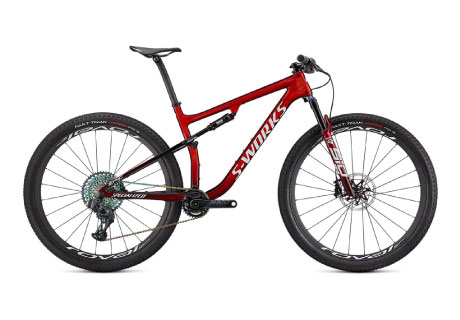
What height is a 29 inch bike for?
Any adult can ride a mountain bike with 29” wheels, but 29ers are the ideal choice for taller riders over 5’7”. The large diameter wheels can feel a bit unwieldy or bulky for shorter riders or riders who aren’t as confident on the trails. Many brands put 29ers on larger frame sizes and 27.5” wheels on small frames to offer a consistent bike fit.
More on 29 inch mountain bikes
The bigger diameter of 29” wheels allows them to reach higher top speeds, roll over large obstacles, and increase stability. Larger wheels have a smaller angle of attack when they come in contact with a rock or root out on the trail and can more easily roll over obstacles. 29ers are the go-to size for downhill mountain bike races where riders need to maintain high speeds over rough terrain.
The larger contact patch of a 29” wheel also means more traction and grip, but not necessarily while cornering. The disadvantage of big wheels is that they can be less agile and responsive while turning or executing quick maneuvers. Check out our catalog and shop 29 inch mountain bikes.
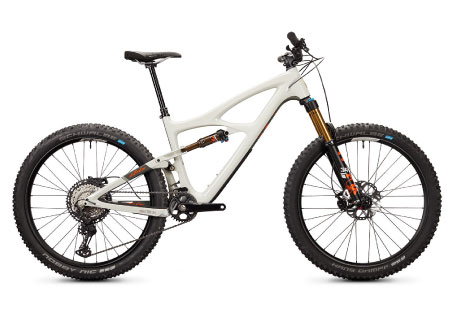
What height is a 27.5 inch bike for?
27.5 inch bikes are suitable for adults between 5’2” and 5’10”. That said, adults of all heights can ride this wheel size. Some brands claim that 27.5” wheels are especially useful for riders 5’7” and under.
More on 27.5 inch mountain bikes
Bike manufacturers like Trek and Giant have realized that matching smaller wheels to smaller frames can make for a better overall fit. Trek’s Smart Wheel Size approach pairs 29” wheels with M, L, and XL frames and puts 27.5” wheels on XS and S frame sizes.
27.5” wheels are more agile and responsive on technical terrain when compared to their 29” counterparts. They are big enough to roll over obstacles better than 26” wheels and small enough to provide nimble handling. As long as you’re not doing intense downhill riding, 27.5” wheels are the ‘goldilocks’ middle wheel size compatible with most terrain and rider heights.
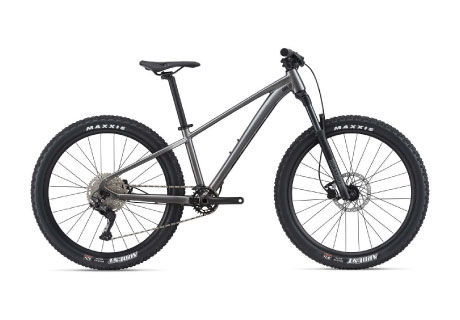
What height is a 26-inch mountain bike for?
A 26” mountain bike is the ideal set-up for younger riders or shorter adults who are between 4’10” and 5’5”. This smaller size is also great for riders that are not as confident on the trails. The smaller diameter 26” wheels are more agile out on the trails and are easier for shorter riders to maneuver over tricky terrain.
More on 26 inch mountain bikes
26” is the most common mountain bike wheel size on old school bikes, many of which are still around today. If you are on the hunt for a retro bike or are fixing up that bike in the garage, odds are it’s paired with a 26” wheelset. Remember that back in the day almost all mountain bikers regardless of height rode bikes with 26” wheels, so if that’s what works for you, feel free to buck the current trend of larger rims.
Bikes designed for dirt jumping utilize 26” wheels with strong alloy rims to handle landings after getting some serious air. Smaller wheels are stronger because they have shorter spokes, making the link between hub and rim less vulnerable to deforming under stress.
Large kids bikes utilize 26” wheels as the last step before tweens are ready to make the jump to adult sized bikes. Kids can continue to build up their riding confidence and skills on 26” wheels and switch later on to bigger mountain bikes.
Is it better to size up or down on a mountain bike?
Size up if… you are a skilled rider or prioritize stability on fast descents.
Choose the smaller size if… you are a less aggressive rider or desire a more upright riding position and nimble bike handling.
If you find yourself between sizes on mountain bike size charts, additional metrics and rider preferences can help you figure out your perfect size. Bike size charts are simply suggestions and are often based on a single height measurement, so they fall short of telling the whole bike fit story. Follow this advice to pick the correct size when you’re right on the edge of two frame sizes.
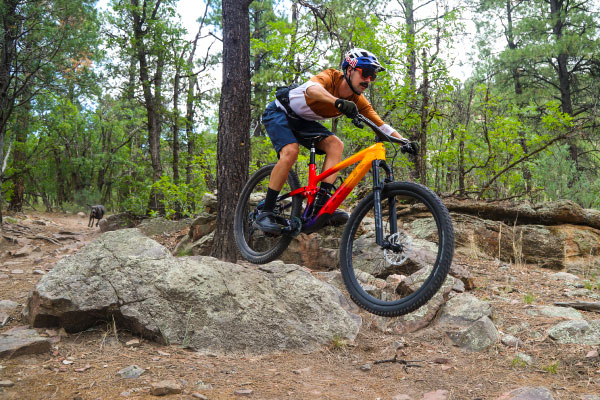
When to size up on a mountain bike
Going a size up means a longer bike with more space between the pedals and handlebars and bigger range of motion when standing up on the pedals.
This extended set up is best for riders with relatively long torsos or who are flexible enough to handle the longer reach.
Bigger bikes will naturally have a slightly longer wheelbase. Wheels farther apart means the bike will be more stable at high speeds and feel hefty rather than nimble on technical trails.
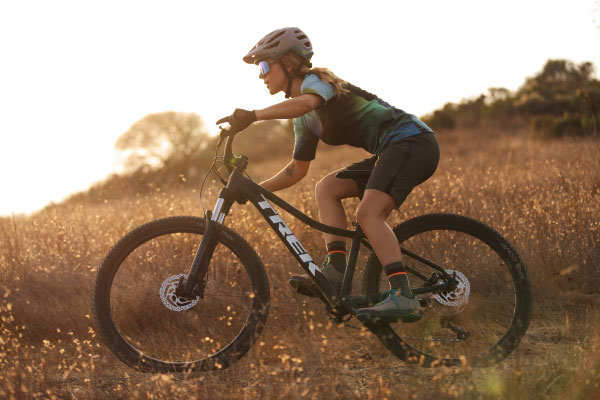
When to size down on a mountain bike
Sizing down is the right option for people that want a more relaxed, comfortable riding position or like agile and responsive bike handling.
Smaller frame sizes have a shorter reach so the handlebars are closer to the seat, placing the rider in a more upright position. This is ideal for less flexible riders or riders with relatively long legs compared to their torso.
The slightly shorter wheelbase provides a more nimble and zippy ride feel. As a less aggressive set-up overall, a smaller frame is the right choice for beginner to intermediate riders.
How mountain bike geometry affects bike size and fit
The overall shape and geometry of a mountain bike is composed of many specific measurements beyond just the frame’s size. Some of the most important measurements to pay attention to when it comes to size are reach, wheelbase, standover height, and stack. These dimensions make a big difference to how a bike will fit your body and perform on certain terrain.
There can be a little bit of number crunching when it comes to frame geometry, but understanding these metrics is key to getting the most out of your bike. There’s plenty to geek out on but don’t worry, we won’t go too far down the rabbit hole.

Reach
Reach on a mountain bike frame is the horizontal distance between the bottom bracket and the center of the head tube. Basically it tells how much room there is between where your feet go and where your hands go on the bike and how much range of motion the rider has while pedaling.
Reach determines how far riders need to lean forward to grab the handlebars while standing on the pedals. MTB riders are frequently standing out of the saddle on descents or while climbing steep sections. Riders need sufficient room to maneuver on technical terrain, but not so much that they are too stretched out. Reach is the most important metric to pay attention to because it changes the between frame sizes.
Too much reach and you’ll be leaning too far forward while in the normal riding position. Short reach means the handlebars are relatively close to your body— riders can feel overly upright with not enough weight over the bottom bracket to pedal efficiently.
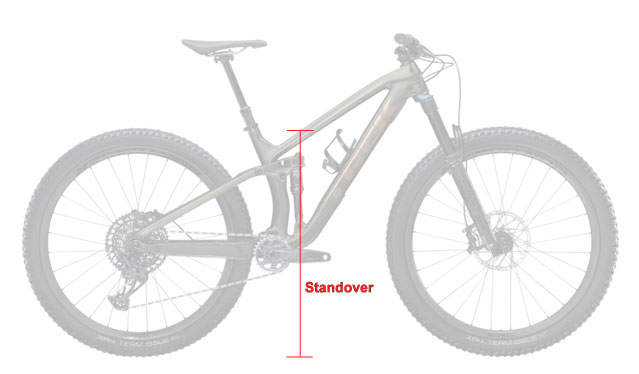
Standover
Standover height relates to how high the top tube is when you are straddling the bike with your feet on the ground. It’s like when you stop at a stop sign and hop off the saddle to stand over your bike frame— there should be at least 2” of clearance between the top tube and your groin.
Standover height is more important for road bikes than it is on modern mountain bikes. MTB frame designs today have quite low standover heights, so it’s never a worry that it’ll be difficult to swing your leg over the frame to mount the bike or that you won’t be able to comfortably straddle the frame. That said, always check you have enough clearance to allow for quick and safe dismounts.
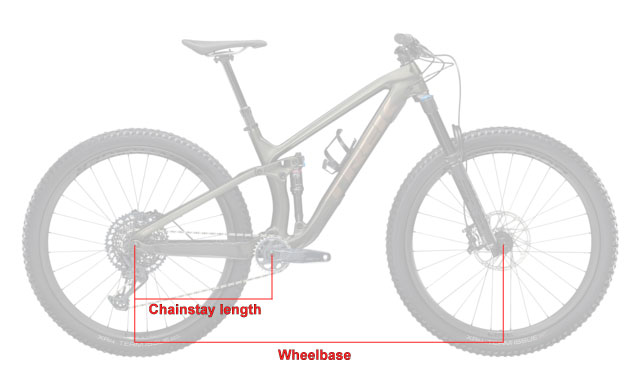
Wheelbase & Chainstay Length
Wheelbase is the horizontal distance between the front and rear axles on a mountain bike. How far apart the wheels are is a major factor that determines whether a bike feels more stable or more nimble.
A longer wheelbase is more stable and is easier to control at high speeds, useful for steep descents or fast trails. Shorter wheelbases means the bike is a bit more compact and will be more maneuverable on technical terrain and around tricky obstacles.
Since wheelbase is essentially a measurement of the frame from one end to the other, wheelbase is made up of other metrics like reach, head tube, angle, and chainstay length added together. It’s important to recognize where the extra length (or lack thereof) is coming from to understand how the overall bike will feel out on the trails.
Chainstay length, or rear center, is another measurement to look at. Chainstays connect the bottom bracket to the rear axle, and longer chainstays provide more stability at speed, while shorter ones feel more nimble. Some models utilize the same chainstay lengths across the size range, but not all.

Stack
Stack is the vertical distance between the bottom bracket and the center of the head tube and determines how a bike will feel while pedaling in the saddle. While still an important metric to consider, stack doesn’t change as much as reach does between frame sizes.
Stack gives riders a clue on how high up the handlebars will be relative to the pedals. If stack height feels too high or low, it can be adjusted with headset spacers or handlebar rise to fit the specific rider.
Let us help you find the right size mountain bike
Even with all the information and advice out there, there’s nothing like test riding the real thing. If you’re still undecided on which size is right for you or want some additional assistance, our bike experts are ready to help.
Visit one of our three Calgary area locations to test ride a mountain bike and find the perfect match. Whether you are seeking performance gains or recovering from an injury, explore the fitting services we offer to achieve a precision bike fit.
Explore Our Top Mountain Bike Brands
Mountain Bike Size FAQs
Why do some mountain bike frames use inches for sizing?
How to size a mountain bike has changed and bikes today are categorized according to alpha sizing (think: S, M, L, XL) rather than the length of the seat tube.
Traditionally, frame sizes were listed in inches, but modern mountain bike designs with their low standover height and diverse geometries prevent seat tube length from being a representative measurement. Bike brands have realized that “size S” is much more intuitive for customers than listing a frame as “15 inches”.
Many bike manufacturers have moved away from gender-specific designs and, instead, offer their bikes in a variety of sizes to fit any rider. For that reason, most brands don’t provide a women’s mountain bike size chart. The mountain bike frame size chart above works well for all types of riders regardless of gender or height.
What size mountain bike should I get for my height?
Riders under 5’5” fit best on either S or XS mountain bike frames, depending on which of those sizes are available. If you are between 5’6” and 5’10”, choose a size M. Riders 5’11” and taller should get an L or XL frame. Check out our mountain bike size chart for an exact recommendation.
What size mountain bike do I need if I'm 6 feet tall?
Riders that measure 6’ tall should ride a size L mountain bike frame. Some bikes use seat tube length instead of alpha sizing to measure their size. Look for a frame size marked between 19” to 20”.
How do you size a mountain bike?
Modern mountain bikes use alpha sizing to categorize frames as XS, S, M, L, or XL. Older mountain bikes used seat tube length, or the vertical distance from the bottom bracket up to the seat post clamp. Check out our mountain bike size chart or the sizing tools on a brand’s website to determine the correct size for you.
How do you measure yourself for a mountain bike?
The most important measurement to take is rider height. Take an updated measurement of your height (or have a friend help you) and compare it to our mountain bike size chart to find out which frame size works best for you.
What size is a medium mountain bike?
A medium mountain bike typically has a frame size of between 16” to 18”. Medium bike frames can fit riders between 5’6” and 5’10”.
Is a 19 bike frame a large?
A 19” bike frame is typically rated as a large frame, appropriate for riders between 5’10 and 6’2”. Depending on the manufacturer and specific model, large bikes can have frames that measure 19”, 19.5”, or 20”.
Is my mountain bike too small?
Feeling cramped, high knees while pedaling, and sitting too upright can be signs that your bike is too small. The reach, or horizontal distance from the bottom bracket to the center of the head tube, should be long enough that you can have a good range of motion both in and out of the saddle.




